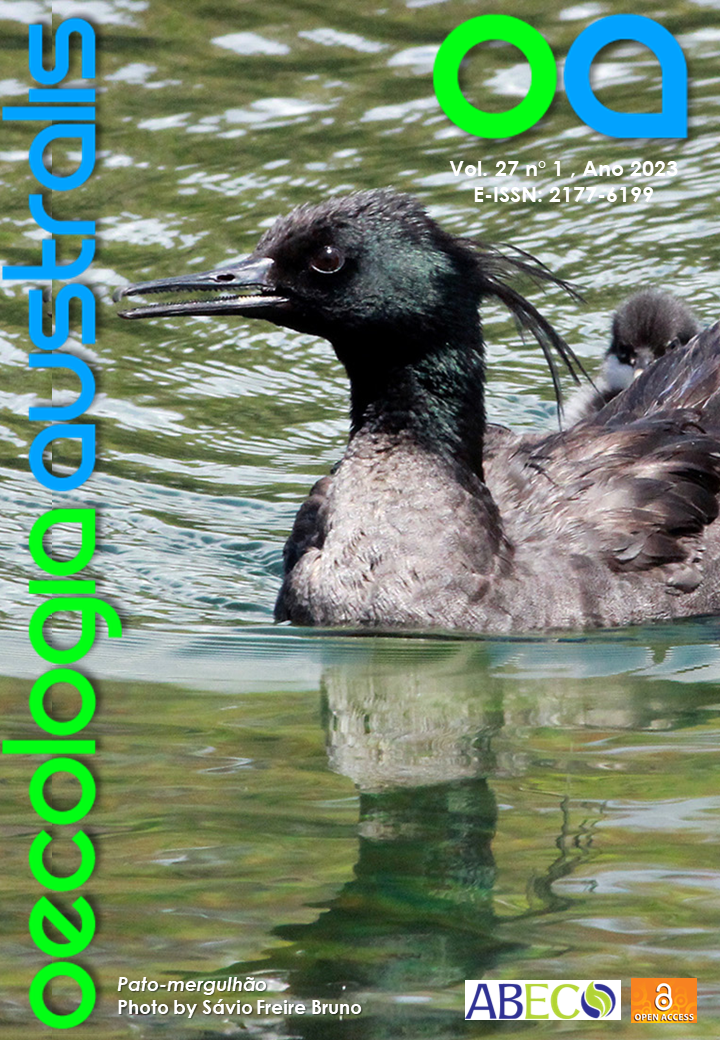STYLAR MOVEMENT IN Talinum Fruticosum (TALINACEAE): CONTRIBUTIONS TO THE REPRODUCTIVE SUCCESS OF THE SPECIES IN POPULATIONS FROM CENTRAL-WEST BRAZIL
DOI:
https://doi.org/10.4257/oeco.2023.2701.07Keywords:
floral movement, herkogamy, pollination, PantanalAbstract
In plant species, the movement of reproductive structures can be an adaptive advantage in mating system studies. This phenomenon can promote outcrossing or cause a reduction in intrafloral male-female sexual interference. Consequently, this contributes to the avoidance of self-pollination and/or delayed autonomous self-pollination. The aim of this short communication is to report the results of assessments done in two natural populations of a native species from central-west Brazil that grows spontaneously and sub-spontaneously in opening and ruderal areas of Pantanal. In this study, the movement of the stigma was recorded throughout floral anthesis, and the mating system was determined. Floral measurements such as: flower opening time, pollen viability and the period that the stigma was receptive were also reported. The formation of fruits by spontaneous self-pollination and cross-pollination reinforces the hypothesis that stylar movement in Talinum fruticosum can facilitate or hinder self-pollination in some situations.
Downloads
References
Agra, M. F., Silva, K. N., Basílio, I. J. L. D., França, P. F., & Barbosa-Filho, J. M. 2008. Survey of medicinal plants used in the region Northeast of Brazil. Revista Brasileira de Farmacognosia, 18(3), 472¬–508. DOI: 10.1590/S0102-695X2008000300023
Aja, P. M., Okaka, A. N. C., Onu, P. N., Ibiam, U., & Urako, A. J. 2010. Phytochemical composition of Talinum triangulare (water leaf) leaves. Pakistan Journal of Nutrition, 9(6), 527–530. DOI: 10.3923/pjn.2010.527.530
Brasileiro, B. G., Cunha, D. F. S., Dias, C. V. W. D., Bhering, M. C., & Cecon, P. R. 2010. Effects of temperature and pre-germinative treatments on seed germination of Talinum triangulare (Jacq.) Willd (Portulacaceae). Revista Brasileira de Sementes, 32(4), 151–157. DOI: 10.1590/S0101-31222010000400017
Bush, S. P., & Beach, J. H. 1995. Breeding systems of epiphytes in a tropical montane wet forest. Selbyana, 16(2), 155–158.
Cardoso, J. C. F., Viana, M. L., Matias, R., Furtado, M. T., Caetano, A. P. S., Consolaro, H., & Brito, V. L. G. 2018. Towards a unified terminology for angiosperm reproductive system. Acta Botanica Brasilica, 32(3), 329–348. DOI: 10.1590/0102-33062018abb0124
Charlesworth, D. 2006. Evolution of plant breeding sys¬tems. Current Biology, 16(17), 726–735. DOI: 10.1016/j.cub.2006.07.068
Elle, E., & Hare, J. D. 2002. Environmentally induced variation in floral traits affects the mating system in Datura wrightii. Functional Ecology, 16(1), 79–88. DOI: 10.1046/j.0269-8463.2001.00599.x
Fenster, C. B., & Martén-Rodríguez, S. 2007. Reproduc¬tive assurance and the evolution of pollination spe¬cialization. International Journal of Plant Sciences, 168(2), 215–228. DOI: 10.1086/509647
Herlihy, C. R., & Eckert, C. G. 2007. Evolutionary analysis of a key floral trait and its effect on the mating system in Aquilegia canadensis (Ranunculaceae). Evolution, 61(7), 1661–1674. DOI: 10.1111/j.1558-5646.2007.00137.x
Kearns, C. A., & Inouye, D. W. 1993. Techniques for Pollination Biologists. Niwot: University Press of Colorado: p. 583.
Klips, R. A., & Snow A. 1997. Delayed autonomous self-pollination in Hibiscus laevis (Malvaceae) American Journal of Botany, 84(1), 48–53. DOI: 10.2307/2445882
Lloyd, D. G. 1992. Self- and cross-fertilization in plants. II. The selection of self-fertilization. International Journal of Plant Biology, 153(3), 370–380.
Pinto, C. E., & Schlindwein, C. 2015. Pollinator sharing and low pollen–ovule ratio diminish reproductive success in two sympatric species of Portulaca (Portulacaceae). Studies on Neotropical Fauna and Environment, 50(1), 4–13. DOI: 10.1080/01650521.2014.972187
Randle, A. M., Slyder, J. B., & Kalisz, S. 2009. Can differences in autonomous selfing ability explain differences in range size among sister-taxa pairs of Collinsia (Plantaginaceae)? An extension of Baker’s Law. New Phytologist, 183(4), 618–629. DOI: 10.1111/j.1469-8137.2009.02946.x
Rathcke, B., & Real, L. 1993. Autogamy and inbreeding depression in mountain Laurel, Kalmia latifolia (ERICACEAE). American Journal of Botany, 80(2), 143–146. DOI: 10.2307/2445032
Ruan, C. J., & da Silva, J. A. T. 2011. Adaptive significance of floral movement. Critical Reviews in Plant Sciences, 30(4), 293-328. DOI: 10.1080/07352689.2011.587715
Ruan, C. J., Teixeira da Silva, J. A., & Qin, P.2010. Style curvature and its adaptive meaning in Malvaceae. Plant Systematic and Evolution, 288(4), 13–23. DOI: 10.1590/S0101-31222010000400017
Shetler, S.G. 1979. Pollen-collecting hairs of Campanula (Campanulaceae), I: Historical review. Taxon. 28(12), 205–215. DOI: 10.1002/j.1537-2197.1993.tb15388.x
Snell, R., & Aarssen, L.W. 2005. Life history traits in selfing versus outcrossing annuals: exploring the ‘time-limitation’ hypothesis for the fitness benefit of self-pollination. BMC Ecology, 5(2), 1–14. DOI: 10.1186/1472-6785-5-2


